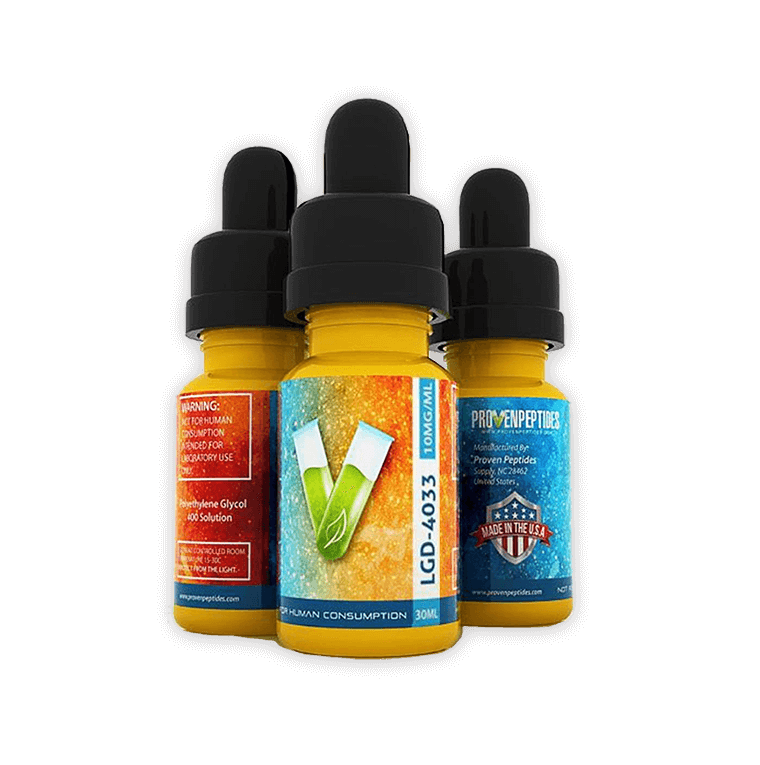
What is Ligandrol (LGD-4033)? A Science-Based Review
LGD-4033 is supposedly the most potent SARM available on the marketplace. It’s now being developed to improve recovery from hip fractures, while its unofficial use remains popular among bodybuilders and those seeking look enhancement. One of all of the hype, read our unbiased review to understand what the true science says about its possible applications.
Disclaimer: By writing this post, we are not recommending this medication. Ligandrol is an unapproved research compound without a complete safety profile, and we just don’t know enough about its adverse effects or effectiveness. Some of our readers who were already taking the drug requested that we commission a post on it, and we are just providing information that is available from the scientific and clinical literature.
We don’t recommend taking Ligandrol for any reason.
What is LGD-4033?
A New SARM
LGD-4033 is a fairly fresh oral selective androgen receptor modulator (SARM). SARMs have gotten a lot of attention recently, both in the medical community and among those that are seeking physical performance and appearance enhancement. Researchers are researching the ways SARMs could be used to overcome muscle bone and preventing ailments.

Bodybuilders feel that they’re safer alternatives to steroids, but there is no information to suggest that unapproved SARMs are safe in any way.
LGD-4033 can also be known as Ligandrol and Anabolicum. LGD-4033 is among the two most well-known SARMs in regards to bodybuilding, MK-2866 (Ostarine) being another.
Like most SARMs, LGD-4033 binds to androgen receptors in the muscles and bones with higher affinity and selectivity. Because of this, scientists hypothesize that LGD-4033 shouldn’t impact other organs (sparing the liver, prostate, and sebaceous glands) or cause acute reduction of your natural testosterone production. Being nonsteroidal, LGD-4033 shouldn’t be converted into estrogen either; these hypotheses are strictly speculative, however, and lacking in clinical data. Future human trials may very well prove them wrong.
Users claim that LGD-4033 is more potent than MK-2866. Other individuals favor MK-2866, particularly in regards to cutting cycles. Both are preferred for their perceived muscle gains, unlike compounds that can cause a long list of side effects and can damage your vital organs.
Yet, this is an unapproved drug. We don’t know how safe it is, or perhaps if it works. We highly recommend against accepting Ligandrol for this particular reason.
Ligandrol or LGD-4033 is a brand new SARM that has become popular among bodybuilders but never went through appropriate clinical trials.
We chose to check into the motives behind LGD-4033’s ongoing popularity and tease aside its real effects. In the following article, we examine the most up-to-date study on its potential uses and supply a summary of its proposed mechanism of action.
Snapshot
Proponents:
- Lean muscle mass increases & enhanced strength
- Fat reduction
- Might help heal and fortify bones
- Few side effects reported in clinical trials
Skeptics:
- Insufficient human study
- Banned in professional sports
- Long-term effects are unknown
- May cause small testosterone reduction
- Insufficient information to determine side effects
- No data to indicate proper dose
How Does LGD-4033 Function?
SARM Action
SARMs can navigate to muscles and bones. They trigger androgen receptors but are chemically different from steroids. As such, they are not substrates for 5 alpha-reductase or CYP19 aromatase, which prevents their conversion into the testosterone metabolite DHT or estrogen:
However, not all SARMs are equally muscle-selective. Some SARMs were abandoned due to their potential for severe side effects. On the other hand, a handful of SARMs is being developed as potential birth control pills for men because they act on the pituitary. All of these are currently theoretical now, with research still ongoing. All such substances may turn out to be ineffective or unsafe in large, high-quality studies.
The very first generation SARMs (developed by Ligand Pharmaceuticals and including LGD-4033) had a small but indisputable impact on lean body mass gains. The next generation of SARMs we are yet to see could be much more potent and selective–but, again, this is highly speculative until better-quality research is conducted.
Scientists are attempting to understand what makes some SARMs better compared to others in the hopes of discovering safer and more selective drugs. Continuing LGD-4033 research should give us additional clues in the not too distant future.
Like most SARMs, LGD-4033 is considered to bind to androgen receptors in the bones and muscles, but its effectiveness, selectiveness, and security remain unknown.

Anabolic Activity
LGD-4033 increases anabolic action in the bones and muscles while decreasing muscle wasting and bone breakdown. This is quite early clinical work, and we will need a great deal more research before we could be confident in this effect.
In one little, early clinical trial, LGD-4033 improved lean body mass and strength, decreased body fat, enhanced health, and improved the healing process. However, the doses and goals of clinical trials differ from their own real usage.
To rewind into the first study phases, both MK-2866 and LGD-4033 were developed with the objective of decreasing muscle wasting in people with muscular dystrophy, the elderly, and cancer patients. Realizing that these drugs may also increase bone strength and healing, scientists began looking into their capability to boost bone diseases like osteoporosis.
Ligandrol was designed with the aim of increasing the anabolic action and reducing muscle wasting in people with serious illnesses.
Fracture Recovery
LGD-4033 was initially created by Ligand Pharmaceuticals, thus the name”Ligandrol”. Viking Therapeutics took over LGD-4033 research in the meantime, renaming it to VK5211. This small Pharma company is exploring LGD-4033/VK5211 for hip fracture recovery. They state that it will hopefully produce all the advantages of testosterone with enhanced safety, aiming to find an approval for its clinical use sometime in the future.
According to their claims, the aims of SARM therapy in people with fractures are to:
- Increase lean body mass
- Increase bone and muscle strength
- Improve physical performance and quality of life
We’re yet to see whether LGD-4033 will gain acceptance according to new clinical trials or not.
Some scientists have hypothesized Ligandrol might improve fracture healing, but this has not been demonstrated.
Bodybuilding
Despite the research being penalized, LGD-4033 entered the bodybuilding community some time ago. It was, at first, classified as a nutritional supplement and recategorized after as a research chemical, along with all other SARMs.
The World Anti-Doping Agency prohibited all SARMs, including Ligandrol, under the S1 Anabolic Agent class of the Prohibited List back in 2008. With this in mind, LGD-4033 can get professional athletes to severe problems. A couple of years ago, LGD-4033 was all over the news for receiving the Florida Gators quarterback, Will Grier, suspended. Will Grier was caught for using it during a routine urine test.
Regardless of the negative media coverage, users are claiming that LGD-4033 is your strongest SARM available on the current market and the only alternative for serious gains without steroids. It’s rivaled only by RAD-140 (Testolone). Without rigorous clinical studies, but these are just anecdotal claims; we currently have no means of knowing whether Ligandrol is really safe or effective.
Ligandrol is still sold illegally, though it’s categorized as a research chemical (not a supplement) and is about WADA’s prohibited list.
Possible Uses of LGD-4033
Insufficient Evidence For:
1) Muscle Wasting
Cancer patients frequently suffer from muscle wasting, which begins early and can reduce the quality of life, chemotherapy tolerance, and survival. SARMs increase muscle mass and enhance fitness in both wholesome people and cancer sufferers. In light of the specificity and safety, SARMs appeared as promising new therapeutics for combating muscle breakdown.
According to their proponents, SARMs may target the same anabolic pathways as standard steroids but without the androgenic side-effects. In the dosage range to increasing muscle mass and function, these people say, they don’t cause detrimental effects on the prostate, skin, or hair. Again, this is now an unproven hypothesis.
Contrary to testosterone, SARMs are orally active and appear unlikely to aromatize to estrogens. Being tissue-selective, SARMs do not lead to hoarseness of the voice and other unwanted symptoms of surplus male sexual hormones.
The only clinical trial so far with LGD-4033 included 76 healthy guys, who all received escalating low doses (0.1, 0.3, and one mg/day). LGD-4033 was well tolerated and safe over 3 months and one mg/day was adequate to increase lean body mass by almost 3 pounds; lower doses didn’t have an effect. LGD-4033 marginally increased leg press strength and stair climb power.
A previous study previously revealed the safety of doses around 22 mg/day. The reduced doses at the larger research, however, have been estimated to optimize lean muscle gains while minimizing side effects. Notice that this data came from animal studies, the objective of which was to ascertain the appropriate dose for future clinical trials. Such animal studies do not reflect the security or efficacy of Ligandrol in humans.
One small trial indicated that Ligandrol might increase lean body mass, hinting in its potential to decrease muscle wasting, but this has yet to be verified.
2) Cachexia
Cachexia is a wider term than muscle wasting. It entails intense weight loss and muscle atrophy, fatigue, and appetite loss. This wasting syndrome is common in patients with AIDS, cancer, kidney disease, sepsis, and acute burns.
The primary contributors are high cytokine levels (IL-6, TNFα, IFN 1b, IFN gamma) and high levels of muscle-degrading molecules (proteolysis-inducing factor). The wasting of respiratory muscles and consequent pneumonia triggers over one-third of cancer-related deaths.
Before scientists realized the potential benefits of SARMs for cachexia, a number of other medications were analyzed. Anabolic steroids such as nandrolone improved cachexia, lean body mass, and bone density in some studies. However, their major drawbacks are severe side effects such as liver toxicity and masculinization in women.
Testosterone, on the other hand, could increase lean mass and muscular performance in HIV-infected men. However, the downside, testosterone increases the probability of prostate cancer, which affects the organs, and causes red blood cell membranes by raising the hematocrit.
Getting discerning, SARMs are viewed as a major breakthrough for cachexia. However, not all SARMs are both safe or effective. According to its proponents, LGD-4033 selectively and potently increases muscle growth without detrimentally affecting the prostate or hematocrit nonetheless, no studies have yet investigated this claim.
By increasing muscle strength, LGD-4033 could increase survival in people with cachexia and may help them better tolerate intensive treatments (such as radio and chemotherapy).
SARMs such as Ligandrol are believed to have the potential for enhancing ataxia (a kind of intense muscle wasting with fatigue), but clinical data are still lacking.
3) Osteoporosis and Fractures
Preventing bone loss and increasing bone formation is crucial to protecting against osteoporosis. The conventional therapy for osteoporosis is far from ideal and SARMs are being researched as a safer choice for increasing bone strength and bone recovery.
Presently, bisphosphonate drugs would be the first-line, in addition to calcium and vitamin D supplements. Bisphosphonates increase bone mineral density by inhibiting bone-degrading cells known as osteoclasts. They also have side effects that are tough to endure for a few.
Women in menopause may be prescribed hormone replacement therapy. However, synthetic hormones like progestins which are frequently part of the regimen raise the chance of breast and uterine lining (endometrial) cancer, and heart disease.
Activating the androgen receptors can increase bone mineral density by increasing the creation of new bones in response to trauma, which is known as the”periosteal reaction”. The periosteum is the connective tissue that covers the outer surface of bones.
The androgen receptors (AR) SARMs are crucial for maintaining bone density and allowing for the recovery of fractures. For example, mice without ARs have reduced bone mineral density (osteopenia). Men undergoing androgen deprivation therapy for longer periods of time also suffer from reduced bone mineral density.
SARMs have the potential to be utilized for osteoporosis in both men and women since they don’t trigger androgen excess. The SARM S-4 completely prevented bone loss In postmenopausal rats, returning their bone mass and strength to the levels of healthy controls. It had been more efficient compared to dihydrotestosterone (DHT).
LGD-4033 studies by Viking Therapeutics are currently penalized. This SARM may see approval in the future for improving recovery following hip fracture surgery. But, it is important to see that future work may reveal Ligandrol to be unsafe or ineffective. It is dangerous to assume that Ligandrol is safer than standard treatments with known safety profiles; a lot of drugs that showed promise in early studies turned out to be downright harmful.
Scientists discovered that Ligandrol may provoke androgen receptors in the bones, potentially helping reduce bone loss. Studies will reveal whether it is good at enhancing recovery after hip fracture surgery.
4) The Brain & Libido
The impacts of SARMs on the mind continue to be an active field of research. It’s well known that testosterone has a large impact on psychosexual and cognitive behavior. SARMs are bone- and – muscle-selective however they also cross in the brain, which can help explain why they are being analyzed for libido and mood enhancement.
It is uncertain how much SARMs affect the brain. On one hand, their effects on cognition could only be a result of increased muscle strength and endurance. On the other, they might, in fact, trigger androgen brain receptors.
In support of the benefits on the brain, Viking Therapeutics asserts that LGD 4033 has got the capability to improve cognition, libido, and energy. Many users report a heightened sense of well being and endurance with this SARM.
Due to a scarcity of study, we don’t yet understand how Ligandrol might affect brain health.
5) Contraception for Guys
Despite some promising research, no male contraceptive pills have reached the marketplace. Even with the increasing need for population management, contraceptive choices available to men are extremely restricted.
Many SARMs alone couldn’t cause the hormonal fluctuations required of a male enhancement pill. Some SARMs are appropriate candidates, as they can inhibit gonadotropins from the pituitary (FSH and LH) but spare the prostate cancer. SARMs may also have a beneficial impact on libido, which might be critical if they were to be utilized as male contraceptives.
Limitations and Caveats
The only proper clinical study was supported by Ligand Pharmaceuticals, who developed LGD. The ongoing studies are financed by Viking Therapeutics, a firm that bought over the rights to LGD-4033 research. It is difficult to objectively assess the quality of research financed by Pharma companies, their conflict of interest, and prejudice. The company-funded research was furthermore very restricted, with no much of significance to say about whether Ligandrol is safe or effective or what the appropriate dose may be.
We advise talking to a physician prior to taking any medication, especially an unscheduled drug with limited long-term safety data in humans.
Takeaway
Ligandrol is an unapproved drug that might increase muscle size and strength. Some people today feel that it has fewer side effects than conventional testosterone replacement therapy, but there is not currently enough information to support this thought.
Speak to your doctor about lifestyle changes or other accepted strategies that may help you accomplish your fitness and wellness objectives, particularly since we do not understand whether Ligandrol is safe.



Sorry, the comment form is closed at this time.